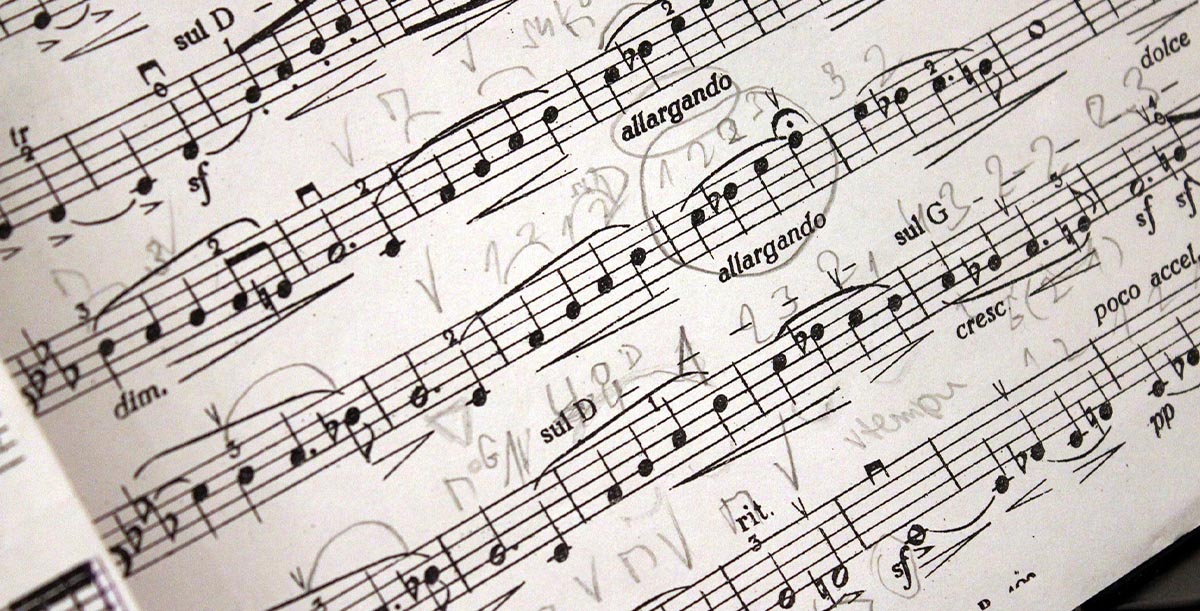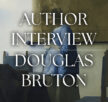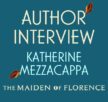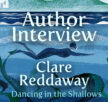The Composer

The composer prefers to address the choir with the manuscript laid out before her, as if she were a priest. She bends over the sheaf of papers, examining the first page. She must have done this a thousand times, but she still worries that one day she’ll turn up and be unable to read what’s in front of her. Yet, as always, with the surety of a sunrise, the lines and dots on the page assemble into coherence.
The composer straightens her back, tapping her fingers on the podium while she waits for silence to fall. It doesn’t always come naturally; sometimes she has to force it. She starts with a prodding sigh, her breath sliding up and down a minor seventh chord.
The crowd comes to attention, turning to her with a hundred expectant faces, most of which she knows, though some have been forgotten with the passage of years. In the front row of the soprano section, a woman who looks a lot like the composer’s older sister stares at her with glossy eyes. Yes, what did you want?
It’s time to start now.
The quiet buzzes with the composer’s fear that this time she won’t be able to coax them into harmony. Others wouldn’t use the term ‘composing’. It’s not an obvious word to use, unless you see things the way the composer does. Even if they shared her view, they might be afraid of the term’s implicit artistic hubris, but the composer finds it helpful to wear a label that at least implies control. She knows it’s an illusion, of course: the choir’s constant shuffling is a reminder that she is at their whim, not the other way around. There is never total silence – somewhere, a chorister is always fidgeting. Right now, the gentleman who looks like a younger version of her father is picking his nose in the bass section; a group of what seem to be her old schoolfriends are whispering behind their manuscripts; and the sisterly soprano at the front is twiddling her hair.
The composer smooths the pages in front of her. Enough with the fear. There is never a good time to begin.
So, this work is basically presentable as it is, but what we’re aiming to do on this run through is inject it with imagination and colour. You can have fun, but not so much that the words aren’t imperative. Remember, this is art, and all art is serious to some degree. Alright, everyone together from the top of page ninety-two. On my mark.
She counts in the sopranos, introducing the next three sections in turn, finishing with the basses, who warm the music with a drone in G major. Further flicks of the wrist split the four parts into eight, then sixteen. The harmonies tessellate the music’s motifs into alternating, complementary strands. The composer once heard from a tutor that an artist only ever really says one thing, returning to the same subject again and again from different angles, their brain subconsciously drawn to imitative counterpoint, like a fugue. The composer hopes that isn’t true of this piece. It feels new, at least to her. Its unity is thrilling, and hearing it come together sends shivers across her shoulders: this could really be something.
Or perhaps, the sisterly soprano implies with a raised brow, it will be the composer’s worst work yet. Given everything that has happened recently, nobody would be surprised.
Either way, the music rolls on, until the tenors come in late and the entire choral conversation falls apart. She restarts them patiently from a few lines before.
Of course it was the tenors – they’re always trying to trip the composer up. They invariably look like her exes in one way or another. Some of them only have a smile, a flop of hair, or a pair of crucifying eyes, the rest of their faces greyed out with forgetting, but she still knows them. Despite her distance from them, their small signature features stand out. Even those she has forgotten entirely stay with her, decaying into the hot, oily core of her identity, compressed beneath the weight of fresher memories.
The ex with the potter’s fingers mimics her hand gestures with his manuscript partner and they snicker through a pair of semibreves. The composer is not impressed.
Stop, stop. Tenors, you have to breathe for at least four beats before you come in: you can’t get a lungful of air in less than a quarter of a second. It isn’t possible. And I don’t want to see you breathing like this – she demonstrates, jaw slack – I need you to put the ‘l’ of ‘lacrimosa’ in your mouth before the time comes. Here, she gives another demonstration, this time with her tongue tucked up against her palate. The words should be immediate – they should punch. You can’t do that if you’re still focussing on formation.
They need to practise the entry another three times before the tenors get it and they can move on. As the choir descend into the final and most complex movement of the piece, the composer begs, Please, don’t half-sing. If you half-sing, I won’t be able to hear when you’re getting it wrong. Just pick a note out of the air and go for it. You can’t fix what you can’t hear is broken.
There are many mistakes. The composer repeats advice to herself that she’s always telling her students with faux authority: well done, you finished. You put something on the page. You filled your staves with song – any song – you can always fine-tune it later. Just finishing is half the battle. Or at least, a solid victory early in the war against the blank page. She breathes deep.
That’s better, the composer says, slicing the air with her hands to stop the music. I can hear what’s going on now. Sopranos, I know that sequence after Figure F is tough to hit, and it’s hard not to make melodies that high sound melodramatic, but doing the pianissimo well will help. Make room in your mouth when singing pianissimo; it takes a lot of room to be quiet. The sisterly soprano shifts and plays with her hair as the composer instructs them. She leans out of her row to pull a face at the impression of their mother in the middle of the altos.
The composer has been avoiding looking at the alto section all session, just in case she spotted Ma, but now her eyes automatically follow her sister’s gaze.
Ma’s changed. In the past, she’s always seemed young, like she was when the composer was five, with the long hair and bell-bottom jeans of the late seventies. That used to be the strongest, most prevailing memory. But it’s been ruined, supplanted by the events of recent weeks. The composer should have guessed this would come up just when she needed her mind to be quiet.
Looking purposefully back to her manuscript, the composer addresses the sopranos. Eyes front, if you would. If you can’t see me, you can’t sing in time.
Sopranos’ attention spans are never long. The composer’s own choirmistress used to say it was because they had to have higher cavities in their mouths in order to reach the top notes, and therefore had less room for brains. Of course, in this choir they’re just an anxious lot, raw and shrill, distracted by the mental cliff-edge they always walk beside. The composer can’t listen when she’s in that state either. Though she’s trying to, right now.
And basses, if you don’t know what you’re trying to sing, don’t just hoover around at the bottom of the scales. It sounds like a beehive operating an octave below where you should be.
Still seeming twenty years younger than he is in real life, the embodiment of her father grumbles under his breath. He glances over to the alto section, then fixes his eyes back on his manuscript.
The composer holds up her palms, ignoring the barbs from her father. I know that contradicts what I said a while ago, but basses, you’re the exception. Also, during that break at the bottom of the page, you have to stop exactly on the beat. The way you stop singing is very simple: just stop moving air through your mouth. The ladies laugh at this, but the gentlemen in the bass section frown. Her father narrows his eyes, making a note in his manuscript so sharply he cracks the tip of his pencil. It can’t be helped: sometimes, silencing one aspect of herself is the only way to make another part heard.
Again, they continue, until – No, no, no, that note’s only a beat long! Three of the tenors tut and stick their hands up in the air, with enough coherence to make her re-examine the script. Ah, you’re right, that’s a type error. Damn. She pauses, humiliated that smudged ink has done a better job of composition than she did in the first draft. Well, let’s just allow that error to become part of the piece, shall we?
The choir laugh, but their amusement stings, and the composer realises she has to find something to criticise or her authority will be undermined. While we’ve stopped, all of you need to turn up the dial on your incision. This language needs to be crisp, precise. It needs to hang in the ears. If we get it wrong, it will just seem as if we’re being self-indulgent. Make it plosive or it will be unsophisticated, yes?
There is an interlude of excellent singing – or at least, as good as it can be for a second draft – before the sopranos slip up. Sopranos, that’s a very nice note, but it’s the wrong one. If we were singing in B minor I’d be delighted, but we’re not, are we? The composer sings the sopranos’ part to demonstrate the correct note, but her voice breaks. That note, but without the horrible crackling. She’s an alto tending towards tenor, and a high F is beyond her reach. It’s always hard, trying to teach a note you can’t sing yourself.
The sopranos attempt it again, and fail, so the composer comes at it from another angle. Okay, look, here’s the note you’re not… don’t sing this note because it’s flat. The composer sings the wrong note for them, but rather than improving on it, the sopranos just copy her directly. No, no. Higher. Higher!
She wishes there was someone else here who could give an objective opinion, but there’s no one. The buck stops with her. She grips the podium and tries not to look into the alto section. But she can’t help it. There’s Ma, the new, abiding memory of her: waxen yellow skin and a mouth that’s permanently ajar, revealing a dehydrated orange colour in the back of her throat.
The composer tucks her head down. She’s not ready for that to appear in her work. Not yet.
But the little soprano girl who’s always carrying the same cuddly bear the composer had as a child has begun to cry. Normally, the little girl runs to the alto mother, but today the sisterly soprano picks her up and whispers to her.
Trapped between the silent manuscript and the drifting choir, the composer realises she’s reached the end of her tether. She’ll have to let the correction with the sopranos wait for a later iteration.
She sags onto the manuscript and rubs her eyes. She isn’t sure how long she’s been at this for. Probably not long enough. It’s never long enough.
I think that’s it for today, she manages. That was good. Ish. But… Look, you need to take responsibility not just for singing the right notes, but for making them beautiful at the same time. Each and every one of you has to take personal responsibility for singing beautifully. You all know what beautiful singing sounds like, therefore you can do it.
The composer closes the manuscript in front of her. The papers shush together in the last of the quiet, before the choir disintegrate into their usual cacophony of internal monologues and dialogues.
The exes snap their manuscripts shut and begin to complain amongst themselves that they can only sing as well as she teaches them to. The child with the bear cries louder and the sisterly soprano loses patience, rolling her eyes and snarling to reveal glistening white teeth.
In amongst the hubbub, Ma steps forth from the alto section. The composer tries to reel away from remembered scents – acid, copper, decay – but she cannot keep her mother away. Ma walks around to stand at the composer’s shoulder, stroking her hair with stiff fingers that catch on the strands, so that even as the composer blinks herself back into the here and now, the grief continues to pluck at her.
Let loose from the composer’s direction, the plurality rises. The plurality roars.
This story forms part of a practice-based research project: the accompanying critical essay, titled ‘Cohesive Plurality: Exploring the relationship between resonance and the act of writing’, is published in LOGOS.
For more short stories, subscribe to our weekly newsletter.














